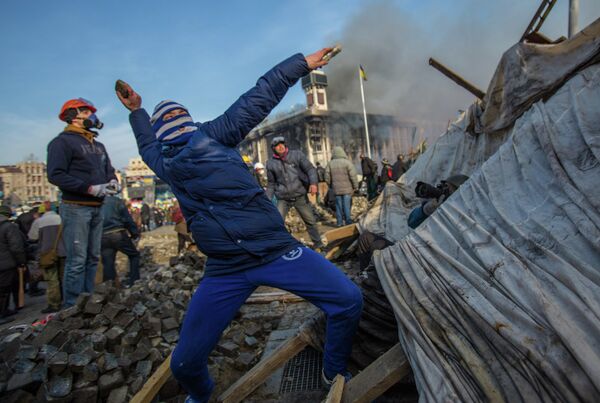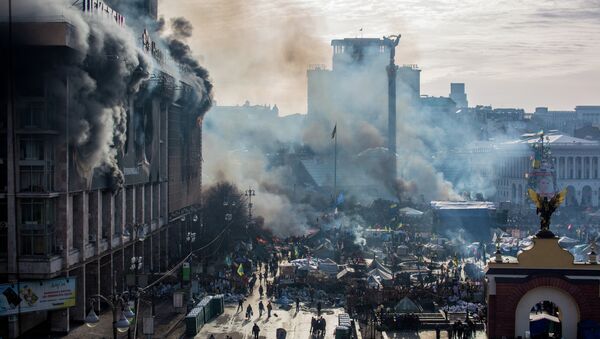MOSCOW, November 21 (Sputnik) – Euromaidan was a mass protest lasting several months that began on November 21, 2013, in the center of Kiev and soon spread to other Ukrainian cities. The protests erupted in response to the suspension of preparations for the signing of an Association Agreement between Ukraine and the European Union by Mykola Azarov's government.
Ukraine suspended its preparations for signing the agreement in order to take steps to ensure national security, a more focused analysis of the country's economic situation and to work out a set of measures to address it. The Ukrainian Cabinet explained its decision with the necessity to develop economic relations with Russia and the CIS.
Shortly after the news of the government's decision was made public, the first messages calling for protest appeared on social networks. About 2,000 people gathered on Kiev's Maidan Nezalezhnosti (Independence Square) that evening. Opposition leaders came to Maidan to support the activists including leader of the Batkyvshchina (Fatherland) Party's parliamentary leader Arseniy Yatsenyuk, Udar Party leader Vitali Klitschko, leader of the nationalist Svoboda Party Oleh Tyahnybok and former interior minister Yuriy Lutsenko.
The opposition declared they would hold public street protests demanding that the agreement be signed at the Eastern Partnership Summit in Vilnius on November 28-29.
The protests began calmly. Up to several dozen people stayed at Kiev's Independence Square and at the European Square in the evening and tens of thousands went there during the day. The situation changed on November 24 when, by the beginning of the scheduled rally, the number of people on European Square soared to 30,000, according to police estimates, and up to 100,000 according to the opposition.
As the rally continued, tents were set up on European Square, and afterward a column of protesters moved to the Cabinet's headquarters and tried to approach the entrance that was cordoned off by the special police unit Berkut. The protesters started throwing smoke grenades and sprayed tear gas at them, who responded with tear gas and by using their batons, although the Interior Ministry denies that the police beat the protesters.
On November 28-29, 2013 the Eastern Summit gathered in Vilnius but Ukraine's Association Agreement was never signed.
In the early hours of November 30 the Berkut unit dispersed the protesters in the center of Kiev and arrested 35 people. Misdemeanor charges were filed against them after which they were all released. Medics say 35 people were hurt. Western officials condemned the tough actions of the law enforcement personnel.
After the Euromaidan protest was curbed, the rallies shifted their emphasis toward the resignation of the government and the president.
On January 16 the Ukrainian parliament passed a number of measures toughening laws on conduct during public rallies. The anti-protest laws provoked further riots.
On January 19 a routine opposition rally turned into clashes between radical opposition activists and law enforcement personnel. The demonstrators tried to break through a cordon of Interior Ministry troops around the government block and threw Molotov cocktails at them. Dozens of police officers were taken to the hospital.
The radical opposition stormed and seized regional administration offices in several regions in Ukraine's west and attempted to seize administration buildings in the central and southern regions of the country.

On January 22 information surfaced about the first victims of the unrest. The death of two participants who clashed with police was officially confirmed. Their deaths were caused by gunshot wounds.
On February 1 opposition leaders Vitali Klitschko and Arseniy Yatsenyuk took part in the Munich Security Conference, where they met a number of leaders from international organizations and western nations.
Mass street riots resumed in Kiev on February 18, the day the opposition demanded the return of parliamentary-presidential rule at the Verkhovna Rada session, by restoring the 2004 Constitution. An aggressive crowd tried to approach the Ukrainian Parliament, while radicals stormed their way into buildings in the center of Kiev, burned car tires and threw stones and Molotov cocktails at police.
According to the Interior Ministry, at least 80 people died in the riots and 800 were wounded.
On February 21 Ukrainian authorities and opposition groups, mediated by the European Union, signed a settlement agreement. Under the agreement, Ukraine"s 2004 Constitution was to have earlier amendments reinstated, a national unity government was to be formed and presidential elections would be held immediately after the adoption of the new Constitution. The authorities and the opposition were also to avoid using force.
On February 22, 2014, a violent coup occurred in Ukraine. The Verkhovna Rada, in violation of the earlier agreements with President Viktor Yanukovych and the opposition leaders, changed the Constitution, changed the speaker of parliament and set a new presidential election for May 25.
Yanukovych was subsequently forced to leave the country fearing for his life. On the same day, the Ukrainian Parliament adopted a resolution cancelling the criminal prosecution of Yulia Tymoshenko, the former Ukrainian prime minister.
On February 23 the Verkhovna Rada appointed Speaker Oleksandr Turchynov the country's acting president.
On February 27 the Ukrainian Parliament approved the so-called national confidence government with Arseniy Yatsenyuk as prime minister.
According to Ukraine"s Health Ministry, 99 people died in the unrest and over 1,000 were wounded. Ukrainian President Petro Poroshenko decreed November 21, the date the protests began in 2013, the Day of Dignity and Freedom.




